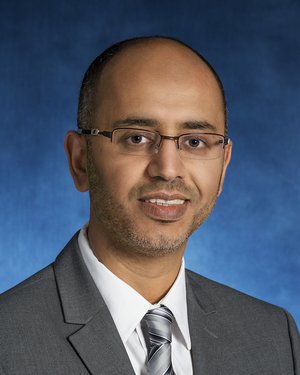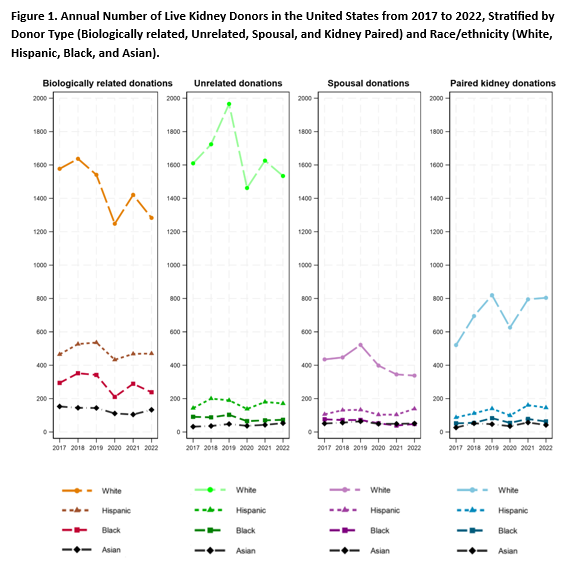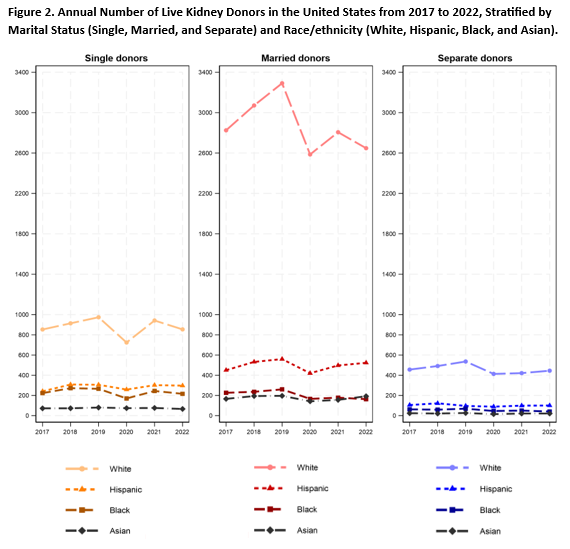
Dr. Al Ammary is a transplant nephrologist, internist, and clinical researcher. He is an Associate Professor of Medicine at the University of California Irvine. He has formal graduate-level training in health services research (PhD). His specific areas of interest are (1) expanding the pool of living kidney donors across race/ethnicity and (2) advancing telemedicine services to enhance outreach and access to living donation and kidney transplantation. He is Chair of the Telemedicine Workgroup, American Society of Transplantation Living Donor Community of Practice.
Broadly, his work focuses on understanding and addressing the critical organ shortage of living donors in the United States. His studies have spanned a spectrum of topics related to my interests and with relevance to epidemiology, healthcare access and outcomes, and health policy.
Fluctuations in living kidney donations in the United States from 2017 to 2022
Fawaz Al Ammary1, Ping Yang2, Simeon Adeyemo1, Krista L Lentine3, Ekamol Tantisattamoa1, Antoney Ferrey1, Uttam G Reddy1, Robert R Redfield III4, Hirohito Ichii4, Allan B Massie5, Dorry L Segev5, Abimereki D Muzaale2.
1Medicine, University of California Irvine, Irvine, CA, United States; 2Surgery, Johns Hopkins University, Baltimore, MD, United States; 3Medicine, Saint Louis University, St. Louis, MO, United States; 4Surgery, University of California Irvine, Irvine, CA, United States; 5Surgery, New York University, New York, NY, United States
Living Donor Transplant Outcome Collaborative (LDTOC).
Introduction: Households across race/ethnicity were socioeconomically impacted by the COVID-19 pandemic. We sought to understand donor subgroups with lasting declines post-pandemic by donor-recipient relationship and donor marital status to guide future interventions.
Methods: Using the Scientific Registry of Transplant Recipients from 1/1/2017 to 12/31/2022, we studied 36188 living kidney donors in the United States. We used Poisson regression to quantify changes in the number of donors (aged<35, 35-49, ≥50 years) in 2020-2022 vs. 2017-2019. A priori, we stratified the study population by donor-recipient relationship or donor marital status (Figures 1 and 2).
Results: Overall, married donors declined the most (12159 to 10666), while only paired donors increased (2745 to 3027). By donor-recipient relationship: biologically related donations continued to decline across race/ethnicity. Unrelated donations declined by 13% among White donors across ages, and by 39% among Black donors aged<35. Paired donations increased by 18% among White donors aged≥50 and 31% and by 65% among Hispanic donors aged<35 and ≥50. By marital status: single donors did not change but declined by 20% and 19% among Hispanic donors aged<35 and 35-49. Married donors declined by 16%, 13%, and 11% among White donors aged<35, 35-49, and ≥50, and by 39%, 33%, and 21% among Black donors.
Conclusions: This study revealed substantial declines in unrelated and married donors post-pandemic, largely driven by White donors across ages. These findings call for efforts to understand and address emerging modifiable barriers to donation.


The data reported here have been supplied by the Hennepin Healthcare Research Institute (HHRI) as the contractor for the Scientific Registry of Transplant Recipients (SRTR).
[1] Living donors
[2] Donor nephrectomy
[3] Kidney transplant
[4] Family
[5] Race
[6] Registry
